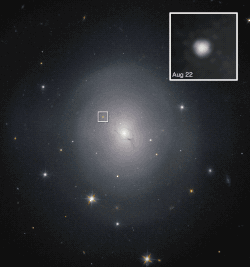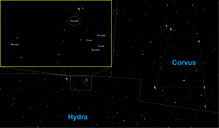NGC 4993
| NGC 4993 | |
|---|---|
 NGC 4993 and GRB 170817A afterglow.[1] | |
| Observation data (J2000 epoch) | |
| Constellation | Hydra |
| Right ascension | 13h 09m 47.7s[2] |
| Declination | −23° 23′ 02″[2] |
| Redshift | 0.009727[2] |
| Helio radial velocity | 2916 km/s[2] |
| Distance (comoving) | 44.1 Mpc (144 Mly)[2] |
| Group or cluster | NGC 4993 Group[3] |
| Apparent magnitude (V) | 13.32[2] |
| Characteristics | |
| Type | (R')SAB0^-(rs)[2] |
| Size | ~55,000 ly (17 kpc) (estimated)[2] |
| Apparent size (V) | 1.3 x 1.1[2] |
| Notable features | Host of neutron star merger detected as gravitational wave GW170817 and gamma-ray burst GRB 170817A |
| Other designations | |
| NGC 4994, ESO 508-18, AM 1307-230, MCG -4-31-39, PGC 45657, WH III 766[4] | |
Coordinates: ![]()

NGC 4993 (also catalogued as NGC 4994) is an elliptical galaxy or lenticular galaxy[5] located about 140 million light-years away[6] in the constellation Hydra.[7] It was discovered on 26 March 1789[8] by William Herschel[7][8] and is a member of the NGC 4993 Group.[3]
NGC 4993 is the site of the first astronomical event detected in both electromagnetic and gravitational radiation, the collision of two neutron stars, a discovery given the Breakthrough of the Year award for 2017 by the journal Science.[9][10] Detecting a gravitational wave event associated with the gamma-ray burst provided direct confirmation that binary neutron star collisions produce short gamma-ray bursts.[11]
Physical characteristics
NGC 4993 has several concentric shells of stars and large dust lane with diameter of approximately a few kiloparsecs which surrounds the nucleus and is stretched out into an "s" shape. The dust lane appears to be connected to a small dust ring with a diameter of ~330 ly (0.1 kpc).[12] These features in NGC 4993 may be the result[13] of a recent merger with a gaseous late-type galaxy that occurred about 400 million years ago.[14] However, Palmese et al. suggested that the galaxy involved in the merger was a gas-poor galaxy.[15]
Dark Matter
NGC 4993 has a dark matter halo with an estimated mass of 193.9×1010 M☉.[14]
Globular Clusters
NGC 4993 has an estimated population of 250 globular clusters.[5]
The luminosity of NGC 4993 indicates that the globular cluster system surrounding the galaxy may be dominated by metal-poor globular clusters.[16]
Supermassive Black Hole
NGC 4993 has a supermassive black hole with an estimated mass of roughly 80 to 100 million solar masses (8×107 M☉).[17]
Activity
The presence of weak OIII, NII and SII emission lines in the nucleus of NGC 4993 and the relatively high ratio of [NII]λ6583/Hα suggest that NGC 4993 is a low-luminosity AGN (LLAGN).[17] The activity may have been triggered by gas from the late-type galaxy as it merged with NGC 4993.[14]
Neutron star merger observations
In August 2017, rumors circulated [18] that a short gamma-ray burst named GRB 170817A, of the sort conjectured to be emitted in the collision of two neutron stars,[19] was detected in this galaxy. On 16 October 2017, the LIGO and Virgo collaborations officially announced the detection of a gravitational wave, named GW170817, seconds before the gamma-ray burst. The gravitational wave signal matched what was predicted for the merger of two neutron stars.[1][20][21][22][23]
AT 2017gfo (also known as SSS17a) is a transient astronomical event believed to be a kilonova, which was observed in NGC 4993 on 17 August 2017, 11 hours after a gravitational wave detection that alerted astronomers to search for an optical counterpart.
GW170817 was a gravitational wave signal observed by the LIGO/Virgo collaboration on 17 August 2017. It triggered a search for a corresponding electromagnetic signal, and the discovery of AT 2017gfo marked the first time one was observed.[20] The gravitational wave signal, which had a duration of about 100 seconds, is the first gravitational wave detection of the merger of two neutron stars, and was associated with GRB 170817A.[22][23][24][25]
GRB 170817A was a gamma-ray burst (GRB) detected by NASA's Fermi and ESA's INTEGRAL on 17 August 2017.[18][26][27][28] Although only localized to a large area of the sky, it is believed to correspond to the other two observations,[24] in part due to its arrival time 1.7 seconds after the GW event.
See also
References
- 1 2 Chou, Felicia; Washington, Dewayne; Porter, Molly (16 October 2017). "Release 17-083 - NASA Missions Catch First Light from a Gravitational-Wave Event". NASA. Retrieved 21 October 2017.
- 1 2 3 4 5 6 7 8 9 "NASA/IPAC Extragalactic Database". Results for NGC 4993. Retrieved 2018-06-03.
- 1 2 Hjorth, Jens; Levan, Andrew J.; Tanvir, Nial R.; Lyman, Joe D.; Wojtak, Radosław; Schrøder, Sophie L.; Mandel, Ilya; Gall, Christa; Bruun, Sofie H. (2017-10-16). "The Distance to NGC 4993: The Host Galaxy of the Gravitational-wave Event GW170817". The Astrophysical Journal. 848 (2): L31. arXiv:1710.05856. Bibcode:2017ApJ...848L..31H. doi:10.3847/2041-8213/aa9110. hdl:2381/41880.
- ↑ Staff (2017). "Galaxy NGC 4993 - Galaxy in Hydra Constellation". dso-browser.com. Retrieved 30 September 2017.
- 1 2 Abbott, B. P.; Abbott, R.; Abbott, T. D.; Acernese, F.; Ackley, K.; Adams, C.; Adams, T.; Addesso, P.; Adhikari, R. X. (2017-12-01). "On the Progenitor of Binary Neutron Star Merger GW170817". The Astrophysical Journal. 850 (2): L40. arXiv:1710.05838. Bibcode:2017ApJ...850L..40A. doi:10.3847/2041-8213/aa93fc.
- ↑ "Your NED Search Results". ned.ipac.caltech.edu. Retrieved 2018-06-05.
- 1 2 "NGC 4993". Deep Sky Observer's Companion. Retrieved 28 August 2017.
- 1 2 "New General Catalog Objects: NGC 4950 - 4999". cseligman.com. Retrieved 2018-06-05.
- ↑ "Breakthrough of the year 2017". Science | AAAS. 22 December 2017.
- ↑ Cho, Adrian (2017). "Cosmic convergence". Science. 358 (6370): 1520–1521. Bibcode:2017Sci...358.1520C. doi:10.1126/science.358.6370.1520. PMID 29269456.
- ↑ Overbye, Dennis (16 October 2017). "LIGO Detects Fierce Collision of Neutron Stars for the First Time". The New York Times. Retrieved 16 October 2017.
- ↑ Blanchard, P. K.; Berger, E.; Fong, W.; Nicholl, M.; Leja, J.; Conroy, C.; Alexander, K. D.; Margutti, R.; Williams, P. K. G. (2017-10-16). "The Electromagnetic Counterpart of the Binary Neutron Star Merger LIGO/Virgo GW170817. VII. Properties of the Host Galaxy and Constraints on the Merger Timescale". The Astrophysical Journal. 848 (2): L22. arXiv:1710.05458. Bibcode:2017ApJ...848L..22B. doi:10.3847/2041-8213/aa9055.
- ↑ Im, Myungshin; Yoon, Yongmin; Lee, Seong-Kook J.; Lee, Hyung Mok; Kim, Joonho; Lee, Chung-Uk; Kim, Seung-Lee; Troja, Eleonora; Choi, Changsu (2017-10-26). "Distance and Properties of NGC 4993 as the Host Galaxy of the Gravitational-wave Source GW170817". The Astrophysical Journal. 849 (1): L16. arXiv:1710.05861. Bibcode:2017ApJ...849L..16I. doi:10.3847/2041-8213/aa9367.
- 1 2 3 Ebrová, Ivana; Bílek, Michal (1 January 2018). "NGC 4993 the shell galaxy host of GW170817: constraints on the recent galactic merger". arXiv:1801.01493 [astro-ph.GA].
- ↑ Palmese, A.; Hartley, W.; Tarsitano, F.; Conselice, C.; Lahav, O.; Allam, S.; Annis, J.; Lin, H.; Soares-Santos, M. (2017-11-09). "Evidence for Dynamically Driven Formation of the GW170817 Neutron Star Binary in NGC 4993". The Astrophysical Journal. 849 (2): L34. arXiv:1710.06748. Bibcode:2017ApJ...849L..34P. doi:10.3847/2041-8213/aa9660.
- ↑ Lee, Myung Gyoon; Kang, Jisu; Im, Myungshin (20 May 2018). "A Globular Cluster Luminosity Function Distance to NGC 4993 Hosting a Binary Neutron Star Merger GW170817/GRB 170817A". The Astrophysical Journal Letters. 859: 1–8. arXiv:1805.01127. Bibcode:2018ApJ...859L...6L. doi:10.3847/2041-8213/aac2e9.
- 1 2 Wu, Qingwen; Feng, Jianchao; Fan, Xuliang (6 March 2018). "The Possible Submillimeter Bump and Accretion-jet in the Central Supermassive Black Hole of NGC 4993". The Astrophysical Journal. 855: 1–7. arXiv:1710.09590. Bibcode:2018ApJ...855...46W.
- 1 2 Drake, Nadia (25 August 2017). "Strange Stars Caught Wrinkling Spacetime? Get the Facts". National Geographic. Retrieved 27 August 2017.
- ↑ Nakar, E. (2007). "Short-hard gamma-ray bursts". Physics Reports. 442: 166–236. arXiv:astro-ph/0701748. Bibcode:2007PhR...442..166N. CiteSeerX 10.1.1.317.1544. doi:10.1016/j.physrep.2007.02.005.
- 1 2 Landau, Elizabeth; Chou, Felicia; Washington, Dewayne; Porter, Molly (16 October 2017). "NASA Missions Catch First Light from a Gravitational-Wave Event". NASA. Retrieved 16 October 2017.
- ↑ Abbott, B. P.; et al. (16 October 2017). "GW170817: Observation of Gravitational Waves from a Binary Neutron Star Inspiral". Physical Review Letters. 119 (16): 161101. arXiv:1710.05832. Bibcode:2017PhRvL.119p1101A. doi:10.1103/PhysRevLett.119.161101. PMID 29099225.
- 1 2 Cho, Adrian (16 October 2017). "Merging neutron stars generate gravitational waves and a celestial light show". Science. doi:10.1126/science.aar2149. Retrieved 16 October 2017.
- 1 2 Krieger, Lisa M. (16 October 2017). "A Bright Light Seen Across The Universe, Proving Einstein Right - Violent collisions source of our gold, silver". The Mercury News. Retrieved 16 October 2017.
- 1 2 Overbye, Dennis (16 October 2017). "LIGO Detects Fierce Collision of Neutron Stars for the First Time". The New York Times. Retrieved 16 October 2017.
- ↑ Abbott, B. P.; et al. (LIGO Scientific Collaboration & Virgo Collaboration) (16 October 2017). "GW170817: Observation of Gravitational Waves from a Binary Neutron Star Inspiral". Physical Review Letters. 119 (16): 161101. arXiv:1710.05832. Bibcode:2017PhRvL.119p1101A. doi:10.1103/PhysRevLett.119.161101. PMID 29099225.
- ↑ Kienlin, Andreas von (17 August 2017). "GCN Circular; Number: 21520; GRB 170817A: Fermi GBM detection; 2017/08/17 20:00:07 GMT". Max Planck Institute for Extraterrestrial Physics. Retrieved 28 August 2017.
- ↑ Castelvecchi, Davide (25 August 2017). "Rumours swell over new kind of gravitational-wave sighting". Nature News. doi:10.1038/nature.2017.22482. Retrieved 27 August 2017.
- ↑ Sokol, Joshua (25 August 2017). "What Happens When Two Neutron Stars Collide?". Wired. Retrieved 28 August 2017.
External links
- "NGC 4993". SIMBAD. Centre de données astronomiques de Strasbourg. Retrieved 28 August 2017.
- "NGC 4993". DSO Browser. Retrieved 28 August 2017.
- Courtney Seligman. "New General Catalog Objects: NGC 4950 – 4999". Retrieved 28 August 2017.
- Hartmut Frommert. "Revised NGC Data for NGC 4993". SEDS. Retrieved 28 August 2017.
- GRB 170817A – NASA/IPAC Extragalactic Database (NED)
- GRB 170817A – Max Planck Institute for Extraterrestrial Physics (MPE)
- GRB 170817A - INTEGRAL Science Data Center (ISDC)
- Starmap
- NGC 4993 on WikiSky: DSS2, SDSS, GALEX, IRAS, Hydrogen α, X-Ray, Astrophoto, Sky Map, Articles and images